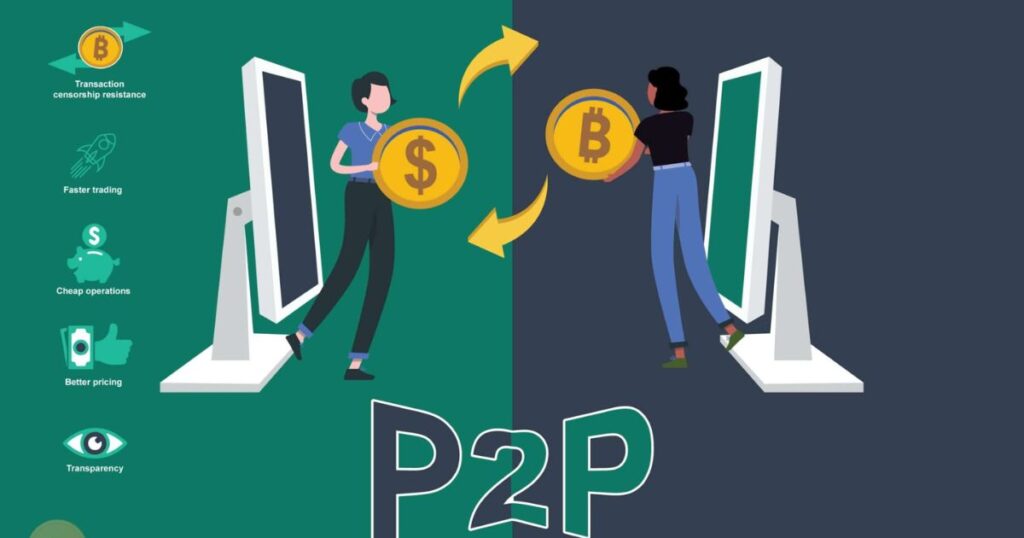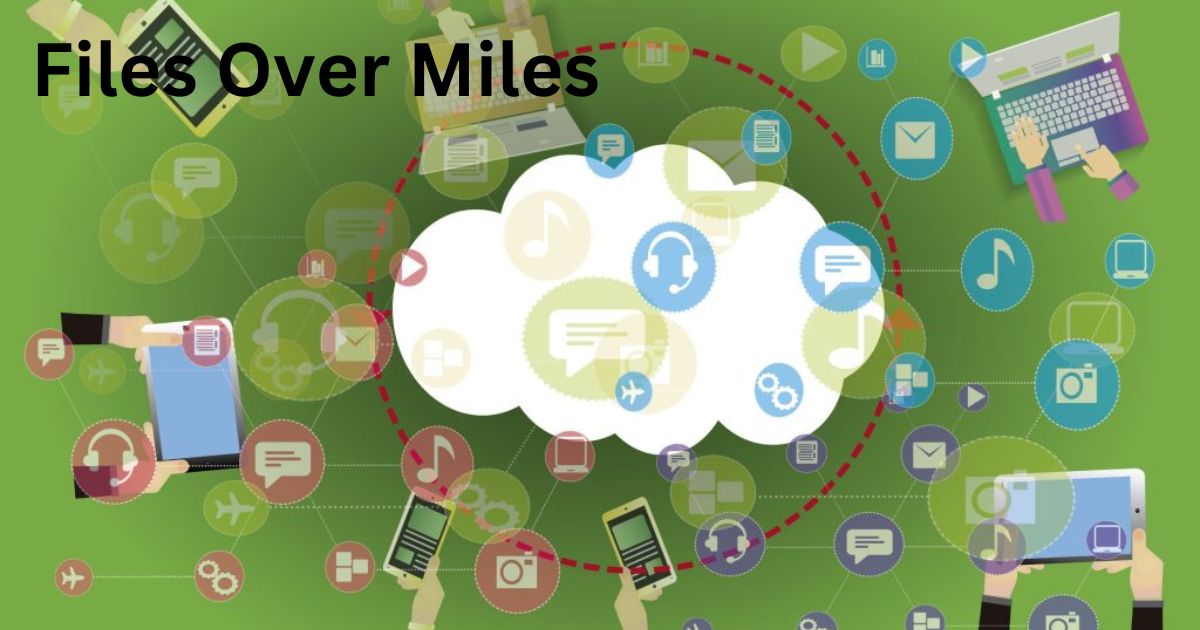Files Over Miles was a game-changer in the world of file sharing. It revolutionized how we thought about transferring large files. Gone were the days of struggling with email attachment limits or dealing with clunky uploads to third-party servers.
With Files Over Miles, you could beam files directly from your computer to someone else’s, no matter how massive they were. It was like having a digital teleporter for your data. Just fire up the service, grab a unique link, and zap – your file would start streaming to its destination in real-time.
Files Over Miles kept things simple, secure, and lightning-fast. It showed us that peer-to-peer file sharing could be a total breeze, opening doors for even more innovative solutions down the line.
What was Files Over Miles?
Overview
Imagine firing off that monster video file to your crew without sweating server uploads or email attachment limits. Files Over Miles was a rad peer-to-peer (P2P) service that let you beam files directly from your computer to theirs, no digital pit stops needed.
How It Worked
This clever tool tapped into WebRTC tech to facilitate real-time communication between browsers. Just pop onto the site, pick your file, and bam – you’ve got a unique link to share with your recipient. When they click that bad boy, the transfer rockets from your machine to theirs in one seamless swoop.
Security Features
But Files Over Miles wasn’t just about convenience – it kept your data on lockdown too. With no file storage on servers, there was less risk of hackers snatching your stuff. Plus, encryption during transfers gave your sensitive bits an extra layer of protection.
How Did Files Over Miles Work?
Initiating a File Share
Let’s walk through how this zippy service fired up a transfer. You’d cruise over to the Files Over Miles site, pick the file you wanted to share, and it would spit out a unique link – like a cyber messenger pigeon ready to wing its way to your pal.
Sharing the Link
This is where the magic happened. You could fling that link over email, text, carrier pigeon – whatever communication method your heart desired. As long as your friend could click it, you were gold.
The Transfer Process
When your pal clicked the link, Files Over Miles did its thing. The WebRTC wizardry opened a direct line between your browsers, and the file started teleporting from your computer to theirs. No muss, no fuss – just a slick P2P handshake.
Completion of the Transfer
While the file streamed its way through the internet ether, you two could spam each other with JPEGs of dogs in sunglasses. Once that sucker finished transmitting, you’d both get a notification high-five letting you know it was mission accomplished.
The Digital Nexus: P2P File Sharing Unveiled

Defining P2P File Sharing
Peer-to-peer file sharing is a web of interconnected computers directly dishing out content to each other, no central servers required. It’s the digital rebel yell that shook up how we access and trade data online.
Its Relevance Today
With businesses spanning the globe and multimedia files getting bigger by the terrabyte, P2P is still a rockstar for real-time distribution. Got a documentary crew upgrading final cuts by the minute? P2P’s your buddy for throwing those beefy files back and forth instantly.
Importance of Efficient File Sharing
Speed and Accessibility
In our lightning-paced world, waiting is not an option. Efficient file sharing lets you access your data from anywhere and get colossal files quickly, rapidly accelerating projects and decisions.
Security and Privacy
As cybersecurity horror stories mount, protecting your data is more crucial than ever. Secure file transfer methods with robust encryption keep your sensitive info away from prying digital eyes.
Collaboration and Innovation
Easy file sharing fosters collaborative environments where diverse teams can seamlessly integrate their expertise. When ideas flow freely, innovation thrives – think digital improvisation.
Cost Efficiency
Why splurge on physical storage solutions when efficient sharing’s a click away? Leaner file management frees up resources to invest where it counts for your business.
The Legacy of LimeWire and Beyond

The Early Days of P2P
P2P’s origins trace back to the dawn of the 2000s and pioneers like Napster and later LimeWire – the renegade services that brought swapping tunes (and…other stuff) to the masses.
Modern P2P Platforms
Today’s P2P has expanded beyond media to hefty software installers, scientific datasets, and more. Players like BitTorrent and eMule let you access the internet’s bounty from virtually anywhere worldwide.
Emerging Trends in File Sharing
Blockchain-Enhanced Security
As hacking exploits escalate, blockchain’s decentralized architecture offers a robust counter by eliminating single points of failure. Integrating this crypto-kudos tech can bolster file sharing security and privacy.
AI-Driven File Management
Artificial intelligence is revolutionizing how we handle and share files with smart algorithms that categorize data, predict needs, and optimize the entire process. It’s like having a hyper-intelligent digital valet.
Cloud-Native Sharing Technologies
Cloud-based architectures are the new frontier for flexible, scalable sharing. As data volumes explode, these cloud-native platforms can effortlessly handle huge global transfers from any device.
Increased Focus on User Privacy
With data privacy concerns hitting the mainstream, there’s a growing demand for anonymous, privacy-first file sharing services. No more catering to creepy third-party trackers or data miners!
Universal Access and Collaboration Tools
Communication hubs like Slack that bake file sharing into their DNA are a game-changer for teamwork. They create shared digital spaces for productivity no matter where your squad is located.
Files Over Miles Key Features
Direct Peer-to-Peer Communication
One of Files Over Miles’ standout features? Direct peer-to-peer file transfers that skipped crappy server stopovers and enabled a nimbler, more secure service.
Browser-Based Accessibility
Rather than another app install, Files Over Miles offered simple browser-based functionality, making it accessible to anyone, anywhere with an internet connection – no strings attached.
End-to-End Encryption
Protecting your data is priority one, which is why Files Over Miles encrypted transfers end-to-end. That way, only you and your recipient could access those files’ juicy contents.
No File Size Limit
Email attachment puny file limits, who? With Files Over Miles, you could blast colossal files –high-def videos, tricked-out game installs, whatever – without compression constraints.
Real-Time Sharing and Downloading
Why wait around once you initiate a transfer? Real-time sharing had your recipients downloading files the second you started the upload. Talk about snappy service.
Harnessing the Power of P2P
Speed and Efficiency
P2P’s ability to simultaneously download from multiple sources gives it a serious speed advantage compared to client-server setups. It’s like going from stream to roaring rapids.
Decentralization and Reliability
Another P2P superpower is resilience. Since files live across the entire network, there’s no single failure point if one host bails. Decentralization makes these systems ultra durable.
Cost-Effectiveness
By reducing the server burden, P2P keeps network traffic and infrastructure costs down for businesses. And individuals get access to content without middlemen fees – a total win-win.
Tackling the Dark Side of P2P
Security Concerns
The open nature of P2P networks makes them inherently riskier for potential malware infections or data breaches. There are some shady corners where the baddies lurk.
Copyright and Legal Issues
While P2P itself isn’t illegal, trading copyrighted material you don’t have rights to can quickly land you in hot water. Know what’s legit to share and what’s a definite no-go zone.
Sail Away from the Storm
Encrypted Cloud Storage
For smoother sailing, services like Google Drive or Dropbox offer encrypted cloud storage and file sharing minus the P2P privacy pitfalls
Secure VPN Services
Virtual private networks (VPNs) create encrypted tunnels for your internet traffic, allowing secure file sharing while masking your IP address. It’s like giving your data an incognito disguise.
FTP/SFTP Services
Old reliables like File Transfer Protocol (FTP) and its secure soulmate SFTP let you directly shuffle files between computers over a network. Simple and straightforward file shipping.
Sneakernet
For a delightfully low-tech option, there’s always the OG “sneakernet” – hand-delivering files via physical media like USB drives. No hacking risk, though a very literal hike may be involved.
P2P Best Practices for a Secure Sharing Experience

Verify File Sources
When you’re downloading P2P files, know exactly who you’re getting them from. Sticking to verified or reputable sources is key for dodging digital d-bags.
Use Security Software
Your standard antivirus/anti-malware tools are P2P’s bodyguards. Keep them updated and run regular scans to sniff out any threats trying to hitch a ride on your downloads.
Monitor Your Network
If your computer’s acting as a P2P node, keep a watchful eye on network activity. Unusual traffic could be a red flag that some shady stuff is going down.
Legal Due Diligence
Avoid an unexpected cameo from the cyberpolice by thoroughly understanding file sharing laws – especially around copyright material. When in doubt, don’t share without the right permissions.
P2P, the Safest Way Forward
Transparent Policies and Practices
For P2P providers, airtight security and content policies are a must to protect users and cover their own bases from legal hot water. Transparency builds trust.
User Education and Resources
Speaking of trust, comprehensive user education around secure P2P habits helps foster a safe community. Platforms should make this info loud and clear for all.
Industry Collaborations
Teaming up with content creators and regulators ensures P2P providers have all their ducks in a row regarding proper licensing and protocols for sharing protected works.
Security Concerns in File Sharing
Malware Risks
Swapping files leaves you open to picking up infected malware packages – a nasty digital illness that can lead to data breaches, crashes, you name it. Steer clear of sketchy downloads.
Data Privacy Issues
Unsecured file sharing puts your personal or business data at risk of exposure. Once that private info slips out, there’s no reeling it back in behind its safe firewall.
Network Vulnerability
Shared files could provide an open door for hackers to sneak onto your network uninvited. Hello, data breaches and other cyber catastrophes you’d rather avoid.
Compliance Risks
For regulated industries, file sharing can accidentally violate compliance protocols for handling sensitive data – and those violations often come with hefty fines attached.
Limitations and Challenges for FilesOverMiles
Technical Constraints
Even a brilliant direct transfer model like Files Over Miles had to grapple with performance variability based on internet quality, devices, and networks. Sluggish times were inevitable.
User Experience Hurdles
Creating a seamless UX that works consistently across multiple browsers is a high-wire balancing act. Any hiccups could frustrate users and impact adoption.
Scalability Issues
As a service attracts more users, efficiently scaling up to handle increased transfer volumes without bogging down is a significant challenge to overcome.
Regulatory Compliance
Navigating the shifting sands of global data laws and copyright rules across borders is a regulatory minefield that’s tough to traverse and maintain legal compliance.
Security and Privacy Concerns
While end-to-end encryption raises the security bar, Files Over Miles still had to continually bolster its protections against evolving digital threats to safeguard privacy.
Maintaining a Competitive Edge
In an ever-changing market, standing out from the pack demands constant innovation to deliver fresh features and enhancements that keep users engaged and interested.
Files Over Miles Alternatives
Traditional Email Services
Let’s not overlook email, that old warhorse still kicking for basic file transferring despite its attachment limits. It’s familiar and hassle-free if you’re not shooting for large volumes.
Cloud-Based Collaboration Platforms
Tools like Microsoft Teams and Slack blend file sharing into productive digital spaces for collaboration. They’re a smart one-stop shop for teamwork across locations.
Specialized Large File Transfer Services
For a dedicated large file transfer solution, platforms like WeTransfer and SendAnywhere provide a streamlined experience tailor-made for effortlessly shooting huge files back and forth.
Direct Device Connection Apps
Apps enabling direct local device-to-device transfers (like AirDrop for Apple users) offer a slick offline method for proximity sharing minus any intermediary service.
Read Also: Xender: Revolutionizing File Sharing in the Digital Era
Future Trends in File Sharing
Rise of Blockchain Technology
Blockchain’s decentralized architecture could revolutionize file sharing security by eliminating central points of failure. Distribute that data across an ultra-secure network.
Enhanced Encryption Methods
As encryption evolves, new methods like quantum encryption and homomorphic encryption may become file sharing gamechangers for privatizing your massive data stores.
Increased Integration with AI and ML
Artificial intelligence and machine learning could help automate and optimize file sharing through predictive analytics, intuitive security protocols, and smart content filtering.
Growth of Edge Computing
Processing data closer to its source via edge computing minimizes latency – a potential boon for ultra-low-lag remote file transferring and IoT devices accessing the cloud.
Expansion of 5G Networks
With broadened 5G rollouts globally, transmission speeds and reliability could soar, enabling even more seamless large file sharing from any location at any time.
The Evolution of File Sharing
From Physical Media to Cloud Storage
File sharing has come a long way since the days of floppy disks and CD-ROMs. The advent of the internet and high-speed connections paved the way for cloud storage services, allowing users to access and share files from virtually anywhere.
The Rise of Peer-to-Peer Networks
Peer-to-peer (P2P) networks emerged as a game-changer, enabling direct file transfers between users without relying on central servers. This decentralized approach offered increased speed, efficiency, and cost-effectiveness, making it a popular choice for sharing large files.
The Impact of Streaming Services
The surge in streaming services has also influenced file sharing practices. Instead of downloading entire files, users can now stream content directly, reducing the need for large file transfers in certain scenarios. However, sharing large media files remains a challenge, and efficient file transfer solutions are still in high demand.
Addressing Legal and Ethical Concerns

Copyright and Intellectual Property Protection
One of the most significant challenges in file sharing has been addressing copyright and intellectual property issues. Illegal sharing of copyrighted material has been a contentious topic, leading to legal battles and the shutdown of various file-sharing platforms.
Fair Use and Creative Commons Licensing
To promote legal and ethical file sharing, initiatives like Creative Commons licensing and fair use provisions have gained traction. These frameworks allow creators to share their work under specific conditions, fostering a more open and collaborative environment while respecting intellectual property rights.
Content Filtering and Monitoring
File-sharing platforms have implemented content filtering and monitoring systems to detect and prevent the sharing of copyrighted material. While not foolproof, these measures aim to strike a balance between enabling legitimate file sharing and protecting intellectual property rights.
The Role of Cybersecurity in File Sharing
Protecting Against Malware and Cyber Threats
As file sharing becomes more prevalent, the risk of malware and cyber threats increases. Malicious actors can exploit file-sharing networks to distribute viruses, ransomware, and other malicious software, compromising user data and systems.
Implementing Robust Security Measures
To address these risks, file-sharing services must implement robust security measures, such as encryption, authentication protocols, and regular security audits. User education on safe file-sharing practices is also crucial to mitigate the spread of cyber threats.
The Importance of Data Privacy
Data privacy is another critical concern in file sharing. Ensuring that sensitive information is not inadvertently shared or intercepted during transfers is of utmost importance, especially in industries handling confidential data or personal information.
The Future of File Sharing: Trends and Innovations
Advancements in Encryption and Security Protocols
As cyber threats continue to evolve, the file-sharing industry must stay ahead by adopting advanced encryption and security protocols. Emerging technologies like quantum encryption and blockchain-based security solutions could revolutionize the way files are shared and protected.
Seamless Integration with Collaboration Tools
The future of file sharing lies in seamless integration with collaboration tools and productivity suites. By embedding file-sharing capabilities within these platforms, users can streamline their workflows and eliminate the need for separate file transfer services.
The Impact of 5G and Edge Computing
The rollout of 5G networks and the rise of edge computing will significantly impact file sharing. With faster speeds and lower latency, users can expect near-instantaneous file transfers, even for large media files, enabling new use cases and applications.
The Democratization of File Sharing
As file-sharing technologies become more accessible and user-friendly, we can expect a democratization of the process. Individuals and small businesses will have access to powerful file-sharing tools previously reserved for larger enterprises, fostering innovation and collaboration across industries.
By addressing challenges related to security, privacy, and legal compliance, while embracing emerging technologies and trends, the future of file sharing holds immense potential for enhanced productivity, collaboration, and data exchange across personal and professional domains.
Exploring the Business Implications of File Sharing

Enhancing Collaboration and Productivity
Efficient file sharing is a catalyst for improved collaboration and productivity within organizations. By enabling seamless exchange of data, ideas, and resources, teams can work cohesively, regardless of their physical locations. This fosters a more agile and responsive work environment, allowing businesses to adapt quickly to changing market conditions and customer demands.
Facilitating Remote Work and Virtual Teams
With the rise of remote work and virtual teams, file sharing has become a critical component of modern business operations. Employees can access and share files from anywhere, enabling real-time collaboration and ensuring that projects progress without interruption. This flexibility not only enhances productivity but also supports a better work-life balance for employees.
Streamlining Supply Chain and Logistics
In industries such as manufacturing, retail, and logistics, file sharing plays a crucial role in streamlining supply chain operations. Sharing digital files like product specifications, shipping documents, and inventory data ensures that all stakeholders have access to the latest information, enabling better coordination and reducing delays and errors.
File Sharing in Specialized Industries
Healthcare and Medical Research
In the healthcare and medical research sectors, secure and efficient file sharing is paramount. Sharing large medical imaging files, patient records, and research data between healthcare professionals and institutions is essential for effective diagnosis, treatment, and collaboration. Strict compliance with data privacy regulations and robust security measures are critical in these domains.
Media and Entertainment
The media and entertainment industry heavily relies on file sharing for collaborative projects, such as film productions, music recordings, and video game development. High-resolution media files, including raw footage, sound files, and graphics, need to be shared seamlessly among teams and stakeholders, often under tight deadlines.
Engineering and Architecture
In the fields of engineering and architecture, large-scale projects involve the exchange of complex design files, blueprints, and 3D models among teams, contractors, and clients. Efficient file sharing ensures that all parties have access to the latest versions of these files, facilitating collaboration and preventing costly errors or delays.
Addressing the Challenges of Large File Sharing
Bandwidth and Network Limitations
Sharing large files can strain network resources and cause bottlenecks, leading to slow transfer speeds and interrupted downloads. Addressing bandwidth limitations and optimizing network infrastructure are crucial to ensuring a seamless file-sharing experience, particularly in environments with high data transfer volumes.
Data Integrity and Version Control
When multiple users are collaborating on a project, maintaining data integrity and proper version control becomes a significant challenge. File-sharing solutions must incorporate features that prevent data corruption, track changes, and ensure that all parties are working with the most up-to-date versions of files.
Compliance and Data Governance
Certain industries, such as finance, healthcare, and government, are subject to strict regulations governing data privacy, security, and retention. File-sharing solutions must comply with these regulations and provide robust data governance features, including access controls, audit trails, and data archiving capabilities.
Embracing Cloud-Based File Sharing Solutions

Scalability and Flexibility
Cloud-based file-sharing solutions offer unparalleled scalability and flexibility, enabling businesses to adapt their storage and bandwidth resources to meet changing demands. This scalability is particularly beneficial for organizations with fluctuating file-sharing needs or those experiencing rapid growth.
Centralized Management and Control
Cloud-based platforms provide centralized management and control over file sharing activities, allowing IT administrators to monitor usage, set access permissions, and enforce security policies across the organization. This centralized approach simplifies administration and enhances overall data governance.
Seamless Integration with Third-Party Applications
Many cloud-based file-sharing solutions offer seamless integration with third-party applications and productivity suites, enabling users to access and share files directly from within their familiar work environments. This integration streamlines workflows and enhances user adoption, ultimately boosting productivity.
As the demand for efficient and secure file sharing continues to grow, businesses must adopt robust solutions that address their specific needs while adhering to industry regulations and best practices. By leveraging the power of cloud computing, advanced security protocols, and user-friendly interfaces, organizations can unlock the full potential of file sharing, fostering collaboration, productivity, and innovation.
Read More:
Geekzilla Tio Geek: Everything You Need to Know
Wordle Newsweek: The Ultimate Guide to Mastering the Popular Word Puzzle Game
FAQ’s
How do I optimize a file transfer?
To optimize a file transfer, follow these tips:
- Use a wired internet connection for faster speeds.
- Close unnecessary programs and browsers to free up bandwidth.
- Compress files before transferring to reduce file size.
- Schedule transfers during off-peak hours when internet traffic is lower.
- Opt for services that allow resuming interrupted transfers.
- Check your internet plan’s data caps and speeds.
How to transfer 100GB files online for free?
Transferring 100GB files online for free is challenging due to the large size. However, you can try:
- Using free file-sharing services with high data limits like Google Drive or Dropbox.
- Splitting the files into smaller chunks and transferring them separately.
- Exploring peer-to-peer file-sharing platforms like BitTorrent or eMule.
- Asking the recipient to provide a cloud storage space for upload. Remember, free services often have speed or data limitations.
How to transfer 30 GB files for free?
To transfer 30GB files for free, consider these options:
- Use free cloud storage services like Google Drive or Dropbox, which offer generous free storage space.
- Split the files into smaller chunks and upload them separately if the service has size limits.
- Utilize free file-sharing platforms like WeTransfer or Firefox Send for temporary file transfers.
- Compress the files to reduce their size before transferring.
- Ask the recipient to create a shared folder on their cloud storage for you to upload.
How are files transferred over the Internet?
Files are transferred over the internet using various protocols and technologies:
- FTP (File Transfer Protocol) and SFTP (Secure FTP) are standard protocols for transferring files between computers.
- HTTP and HTTPS are used for web-based file transfers, such as downloading files from websites.
- Peer-to-peer (P2P) networks enable direct file sharing between users without a central server.
- Cloud storage services facilitate file uploads and downloads from remote servers.
- Email attachments are another common method for smaller file transfers. The specific method used depends on factors like file size, security requirements, and available infrastructure.
Final Words
Files Over Miles was a revolutionary file-sharing service that allowed direct browser-to-browser transfers. No more struggling with email limits or third-party uploads! Just visit the site, select your file, and get a unique link to share.
When your friend clicked that link, the file would beam straight from your computer to theirs – simple as that. But Files Over Miles wasn’t just about convenience – it encrypted transfers for extra security.
Although it’s faded from the limelight, this innovative tool paved the way for today’s safe, prompt file-sharing solutions. It showed us peer-to-peer transfers could be a total breeze while keeping data locked down tight. A pioneering service that reshaped how we think about zapping files across the web.

Ethan Pelsaert, a tech enthusiast and avid writer for TechCleen.com, delves into the realms of tech gadgets, smartphones, social media, computers, and emerging technologies. With a passion for innovation, John explores and shares insights on the latest trends shaping our digital world











